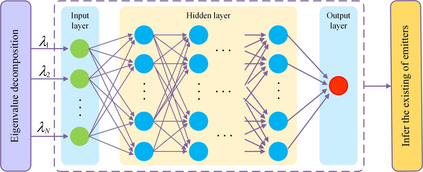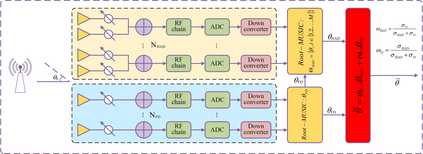Due to a high spatial angle resolution and low circuit cost of massive hybrid analog and digital (HAD) multiple-input multiple-output (MIMO), it is viewed as a key technology for future wireless networks. Combining a massive HAD-MIMO with direction of arrinal (DOA) will provide a high-precision even ultra-high-precision DOA measurement performance approaching the fully-digital (FD) MIMO. However, phase ambiguity is a challenge issue for a massive HAD-MIMO DOA estimation. In this paper, we review three aspects: detection, estimation, and Cramer-Rao lower bound (CRLB) with low-resolution ADCs at receiver. First, a multi-layer-neural-network (MLNN) detector is proposed to infer the existence of passive emitters. Then, a two-layer HAD (TLHAD) MIMO structure is proposed to eliminate phase ambiguity using only one-snapshot. Simulation results show that the proposed MLNN detector is much better than both the existing generalized likelihood ratio test (GRLT) and the ratio of maximum eigen-value (Max-EV) to minimum eigen-value (R-MaxEV-MinEV) in terms of detection probability. Additionally, the proposed TLHAD structure can achieve the corresponding CRLB using single snapshot.
翻译:高空间角分辨率和高超精度的DOA测量性能,甚至超精度的DOA测量性能,接近完全数字的MIMO。然而,阶段模糊性是大规模HA-MIMO DOA估算的一个难题。在本文中,我们审查了三个方面:检测、估算和低分辨率ADC(CRLB),接受者为低分辨率ADC(CRLB)。首先,提出多层神经网络(MLNN)检测器,以推断被动排放者的存在。然后,建议两层MAD(THAD)MIMO结构,仅用一分光片来消除阶段模糊性。模拟结果显示,拟议的MLNN(MN)探测器比现有通用概率(GRLT)测试(GRLT)低分辨率,使用最低SVAV-M(MA-RVAAA) 最低水平的SVVAVA-M(OVA-VA-OL) 和最低水平(GRLAVA-RVA-VAVA-O-VAVAVAVAVAVAVA-OI) 最低值(CILILI值(CILILILILILILILILILI)的拟议值)的比例要)的拟议最低比。






